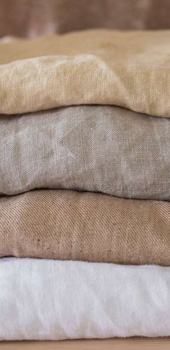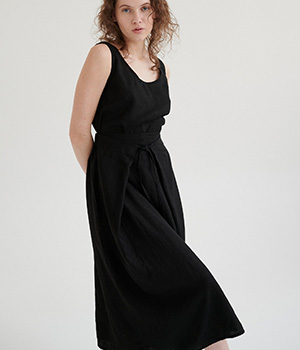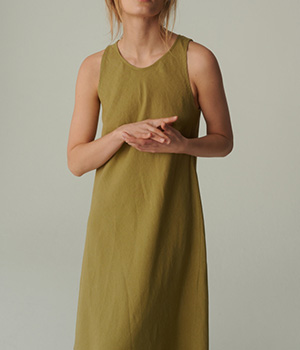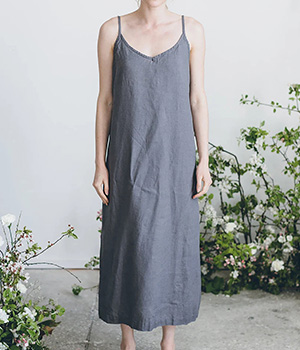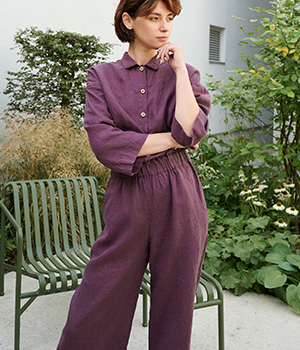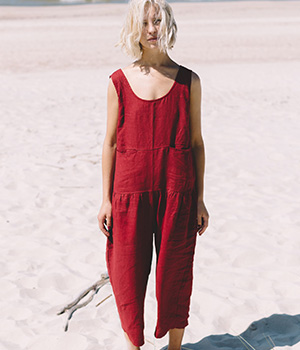Which Country is Famous for Linen Clothes?
Why Linen Matters in Fashion and Function
Linen is more than just fabric—it's a sustainable, breathable, and elegant material that has been cherished for thousands of years. But which country is famous for linen clothes? Understanding its origins, history, and top producers helps us appreciate its quality, especially when choosing a trusted manufacturer like Linenwind.
A Quick History of Linen – Ancient Roots to Modern Craft
Linen traces its origins to prehistoric times. In the Caucasus Mountains (modern-day Georgia), dyed wild flax fibers were discovered, dating back over 30,000 years. Ancient Egyptians prized linen so much that it was used for burial shrouds and as a status symbol in daily wear. It wasn’t just clothing; it was cultural and religious.
In medieval Europe, linen held economic importance. By the 11th century, Germany, Flanders, and Brabant were major centers of flax cultivation and linen weaving. In Ireland’s Ulster region, Lisburn earned the nickname "Linenopolis" as it became a top linen hub in the 18th and 19th centuries. Meanwhile, Russia led flax fiber production in the early 20th century, supplying around 80% of the world’s flax.

Who Reigns Supreme Today?
China – The Global Leader in Production
Currently, China is the world’s largest producer of linen, exporting more than any other country, thanks to extensive cultivation and processing capabilities. However, production volume doesn’t always equal premium quality.
Belgium – The Benchmark for Premium Linen
Belgium is widely regarded as the gold standard. Renowned for its exceptional quality, Belgian flax and weaving are governed by strict standards. The “Belgian Linen” label, backed by the Belgian Flax and Linen Association, guarantees that at least 85% of the product is EU-sourced flax fiber and meets robust quality benchmarks. Historic mills like Libeco, founded in 1864, continue to produce luxurious linen globally.
Currently, China is the world’s largest producer of linen, exporting more than any other country, thanks to extensive cultivation and processing capabilities. However, production volume doesn’t always equal premium quality.
Belgium – The Benchmark for Premium Linen
Belgium is widely regarded as the gold standard. Renowned for its exceptional quality, Belgian flax and weaving are governed by strict standards. The “Belgian Linen” label, backed by the Belgian Flax and Linen Association, guarantees that at least 85% of the product is EU-sourced flax fiber and meets robust quality benchmarks. Historic mills like Libeco, founded in 1864, continue to produce luxurious linen globally.
Ireland – A Storied Tradition
Irish linen also holds a revered place in textile history. While most flax is now imported from Northern France, Belgium, and the Netherlands, Irish spinning and weaving craftsmanship remain. The Irish Linen Guild ensures authenticity by certifying only fabrics spun and woven in Ireland. Irish linen remains synonymous with luxury.
Other European Contenders
Flax fields in the Netherlands, France, Lithuania, and Italy contribute to Europe’s high-quality linen pool. Combined, these countries define “fine European linen.”
Other European Contenders
Flax fields in the Netherlands, France, Lithuania, and Italy contribute to Europe’s high-quality linen pool. Combined, these countries define “fine European linen.”
Comparing Linen Production Across Countries

Linen Clothing: Comfort Meets Sustainability
Why do linen clothes matter in today sustainable fashion world?
- Breathability & Comfort: Natural moisture-wicking fibers keep you cool in warm weather.
Spotlight on Linenwind: Your Premium Manufacturer
- Durability: Strong flax fibers result in garments that soften with age yet maintain integrity.
- Eco-Friendly Production: European producers, especially Belgium and Italy, often use low-impact processing.
- Luxury & Aesthetics: Fine drape, natural luster, and elegant slubs define premium linen.
Spotlight on Linenwind: Your Premium Manufacturer
As you explore linen clothing, consider partnering with a manufacturer who values both quality and sustainability. Linenwind blends all these strengths.
- 20+ years of experience in high-end linen and cotton clothing.
- Sustainable philosophy: eco-friendly materials, renewable resources, natural dyes.
- Custom manufacturing (OEM/ODM): Flexible minimum order quantity of only 30 pieces—perfect for small brands and wholesale buyers.
- Global reach: Expanding to Europe and North America with smart, transparent production.
- Founder involvement: Every garment reflects care, from sustainable design to eco-friendly production.

Combining Global Linen Prestige with Linenwind Edge
As you question which country is famous for linen clothes, here how Linenwind fits in:
1. Premium raw materials: Sourcing high-quality European flax fibers aligning with Belgian and Irish standards.
2. Responsible production: Oversight of smart factory processes ensures consistency and quality akin to Belgian craftsmanship.
3. Customization: Tailored designs, styles, and fits—even starting from 30-piece orders—enable differentiation in the market.
4. Eco-focused brand narrative: Linenwind provides your brand with sustainable credentials, appealing to mindful consumers.
1. Premium raw materials: Sourcing high-quality European flax fibers aligning with Belgian and Irish standards.
2. Responsible production: Oversight of smart factory processes ensures consistency and quality akin to Belgian craftsmanship.
3. Customization: Tailored designs, styles, and fits—even starting from 30-piece orders—enable differentiation in the market.
4. Eco-focused brand narrative: Linenwind provides your brand with sustainable credentials, appealing to mindful consumers.
Sample Case: Linenwind Custom Linen Tops & Shorts
- 3/4 Sleeve Check Linen Top: 100% natural linen, breathable, perfect for spring/summer, tailored OEM support, eco-conscious sourcing.
- High-Waist Linen Shorts: Light, comfortable, western-retro pattern with European-friendly styling, ideal for boutiques and e-commerce.
Use these key points to promote your linen clothing line:
- Highlight craftsmanship: Tell the history of linen—from Egyptian linens to Lisburn mills—tying in Linenwind’s values.
- High-Waist Linen Shorts: Light, comfortable, western-retro pattern with European-friendly styling, ideal for boutiques and e-commerce.
Integrating Heritage into Modern Marketing
Use these key points to promote your linen clothing line:
- Highlight craftsmanship: Tell the history of linen—from Egyptian linens to Lisburn mills—tying in Linenwind’s values.
- Certify quality: Back claims with standardized practices akin to Belgian Linen and Irish Linen Guild traceability.
- Educate customers: Explain linen’s eco credentials and manufacturing superiority.
- Showcase your MOQ flexibility: Emphasize custom orders from 30 pieces, ideal for small brands and fast fashion.
- Sustainability messaging: Use eco-dye, renewable materials, and founder involvement as proof of commitment.
Summary: Linen's Prestige + Linenwind Promise
The question “Which country is famous for linen clothes?” finds its answer in Europe—especially Belgium and Ireland—where tradition meets stringent quality. Yet through smart sourcing and ethical production, Linenwind merges this prestige with modern custom manufacturing and sustainable ethos. Whether you’re a boutique brand or retailer, Linenwind offers:
- Premium European-grade raw materials
- Premium European-grade raw materials
- Customizable manufacturing, MOQ 30 pieces
- Eco-conscious, transparent production
- Brand storytelling rooted in heritage and sustainability
Frequently Asked Questions
What sets Belgian Linen apart?
Strict quality standards—Belgium requires at least 85% EU flax fiber and certification via the Belgian Flax and Linen Association.
Is Irish linen still made in Ireland?
Can small brands order custom linen from Linenwind?
What eco-practices does Linenwind follow?
Why is linen pricier than cotton?
Which country produces the most linen?
Strict quality standards—Belgium requires at least 85% EU flax fiber and certification via the Belgian Flax and Linen Association.
Is Irish linen still made in Ireland?
Yes—though the flax is imported, the spinning and weaving occur in Ireland to earn the Irish Linen Guild mark.
Can small brands order custom linen from Linenwind?
Yes—Linenwind offers custom manufacturing with a low minimum of 30 pieces per design.
What eco-practices does Linenwind follow?
They use renewable materials, natural dyes, and lean manufacturing processes to minimize environmental impact.
Why is linen pricier than cotton?
Linen demands more labor—from retting to weaving—and yields less fabric per harvest, but offers richer texture, durability, and eco-friendliness.
Which country produces the most linen?
China leads in volume, but when evaluating quality and craftsmanship, Belgian and Irish linen hold the top global reputation.
Final Thoughts
By combining Europe's top linen-producing legacy with Linenwind’s flexible, sustainable manufacturing, you can elevate your linen clothing brand. Highlight your roots, certify your quality, and promote custom eco-friendly fashion—with your first order starting at just 30 pieces.
Linen in Modern Fashion Trends
Linen isn’t just a historical textile—it’s dominating contemporary fashion runways and minimalist wardrobes worldwide. From Paris to Seoul, eco-conscious fashion houses are embracing linen for its texture, breathability, and authenticity.
Linen fits perfectly into the “slow fashion” movement. Shoppers now seek pieces that last longer, feel better, and align with their values. Linen's natural wrinkles are no longer considered flaws—they’re signs of authenticity and character. Influencers and stylists worldwide are pairing wide-leg linen trousers with neutral tops or styling oversized linen shirts with shorts and sandals for a beach-to-city transition.
Major retailers and indie designers alike are incorporating linen clothing manufacturers into their supply chains to meet this demand. And that’s where Linenwind stands out—not only for offering wholesale and custom orders but also for helping brands maintain ethical sourcing narratives that resonate with Gen Z and Millennial shoppers.
Linen fits perfectly into the “slow fashion” movement. Shoppers now seek pieces that last longer, feel better, and align with their values. Linen's natural wrinkles are no longer considered flaws—they’re signs of authenticity and character. Influencers and stylists worldwide are pairing wide-leg linen trousers with neutral tops or styling oversized linen shirts with shorts and sandals for a beach-to-city transition.
Major retailers and indie designers alike are incorporating linen clothing manufacturers into their supply chains to meet this demand. And that’s where Linenwind stands out—not only for offering wholesale and custom orders but also for helping brands maintain ethical sourcing narratives that resonate with Gen Z and Millennial shoppers.
How to Choose a Reliable Linen Clothing Manufacturers Partner
Choosing the right linen clothing manufacturers partner can define your fashion brand’s identity. With so many suppliers in the market, here are the essential traits to consider:
- Transparent sourcing: Do they disclose the origin of the flax fibers? Linenwind proudly sources from trusted European suppliers.
- Transparent sourcing: Do they disclose the origin of the flax fibers? Linenwind proudly sources from trusted European suppliers.
- Minimum order flexibility: Most manufacturers demand high MOQs. Linenwind, however, empowers small labels with a low starting MOQ of just 30 pieces.
- Customization options: From private labels to embroidery and dye techniques, your supplier must be versatile.
- Communication & support: A responsive team ensures smoother collaboration. Linenwind assigns dedicated customer support to each project.
- Eco certifications: Ask if they follow OEKO-TEX®, GOTS, or use AZO-free dyes. Linenwind uses low-impact dyes and complies with global
sustainability benchmarks.
sustainability benchmarks.
This checklist alone places Linenwind among the most accessible and trusted linen clothing manufacturers globally.

Inside Linenwind: The Eco-Driven Manufacturing Journey
Let’s go behind the scenes.
Design & Sample Development:
Fabric Sourcing & Cutting:
Sewing & Finishing:
Eco-Friendly Dyeing:
Quality Control & Packaging:
Shipping:
Design & Sample Development:
You share your ideas, sketches, or reference images. The design team reviews every detail—from stitching techniques to neckline shape—and offers fabric swatches. Linenwind also helps optimize sizing for Western and Asian markets.
Fabric Sourcing & Cutting:
Only certified European linen or blends make the cut. After finalizing fabric rolls, precision cutting ensures minimal waste.
Sewing & Finishing:
Experienced tailors construct garments in clean, ethical workshops. Seams are reinforced. Loose threads? Never. Buttons are quality-tested. Zippers, eco-sourced.
Eco-Friendly Dyeing:
Dyes are water-saving and non-toxic. Many pieces are also left un-dyed for a raw, natural linen look.
Quality Control & Packaging:
Each piece is inspected. Eco-packaging options—like recyclable kraft bags—can be branded for boutique shipment.
Shipping:
Global shipping from Asia’s key ports, with transparent tracking and customs handling.
This structured, transparent approach defines Linenwind’s promise: reliable, aesthetic, sustainable.
How to Care for Linen Clothing
Many consumers hesitate to buy linen because they think it’s “high-maintenance.” But with just a few tips, it’s easy to extend the life of your garment:
- Washing: Use cold or lukewarm water on a gentle cycle. Avoid bleach—it weakens flax fibers.
- Drying: Air dry flat or hang on a padded hanger. If using a dryer, remove while slightly damp to reduce wrinkles.
- Ironing: Use medium heat while the garment is still slightly damp. But remember—those creases are part of the charm!
- Storing: Store in a cool, dry space. Avoid plastic bags that trap moisture.
Linenwind includes a care card in every bulk order—an added value for your customers.

Linen in Global Culture and Travel
Few fabrics have transcended cultures like linen.
In Japan, linen is blended with cotton to create airy summer yukatas. In Italy, it’s the unofficial fabric of coastal summer suits and flowing dresses in Positano. In Africa, especially Nigeria and Ghana, designers incorporate linen into modern interpretations of traditional attire. In India, linen kurtas are seen as premium alternatives to cotton during festivals.
In Japan, linen is blended with cotton to create airy summer yukatas. In Italy, it’s the unofficial fabric of coastal summer suits and flowing dresses in Positano. In Africa, especially Nigeria and Ghana, designers incorporate linen into modern interpretations of traditional attire. In India, linen kurtas are seen as premium alternatives to cotton during festivals.
Travelers worldwide now seek linen as a lightweight, chic travel essential. It packs well, breathes beautifully in hot climates, and suits beachside cafés just as well as city galleries.
Linenwind globally-inspired collections draw from these influences—offering modern silhouettes with cultural nods.
Expanded FAQs
Is linen suitable for all seasons?
What is the difference between flax linen and cotton-linen blends?
Can I create my own designs with Linenwind?
What colors are best for linen garments?
What’s the shipping turnaround from Linenwind?
Absolutely. While most known for summer, medium-weight linen layered over merino wool or under coats makes for breathable winter wear too.
How do I verify the sustainability of my linen source?
Ask your linen clothing manufacturers for flax origin, dye certifications, and carbon offsets. Linenwind’s full process is traceable and transparent.
What is the difference between flax linen and cotton-linen blends?
Flax linen is 100% from the flax plant and offers a more textured, crisp finish. Blends often soften the fabric and reduce cost—great for T-shirts and casualwear.
Can I create my own designs with Linenwind?
Yes, they offer OEM/ODM services. Just submit sketches or tech packs. Linenwind even helps you improve design functionality if needed.
What colors are best for linen garments?
Natural tones—beige, off-white, khaki—are timeless. However, rich tones like rust, navy, or sage green are trending in 2025.
What’s the shipping turnaround from Linenwind?
Typically 30–45 days including sample finalization, production, and shipping. Express services are available upon request.

Final Thoughts: Why Linenwind Should Be Your Linen Clothing Manufacturers
As consumer preferences shift toward conscious fashion, linen continues to rise as the fabric of the future—rooted in history, rich in comfort, and sustainable by nature. But sourcing quality linen garments requires more than trend awareness—it demands a reliable manufacturing partner. That’s where Linenwind, a leader among linen clothing manufacturers, delivers unmatched value. With ethical production, global sourcing, and customizable solutions starting from just 30 pieces, Linenwind helps brands of all sizes bring timeless, breathable fashion to life. Choose tradition, innovation, and trust—choose Linenwind for your next linen collection.




